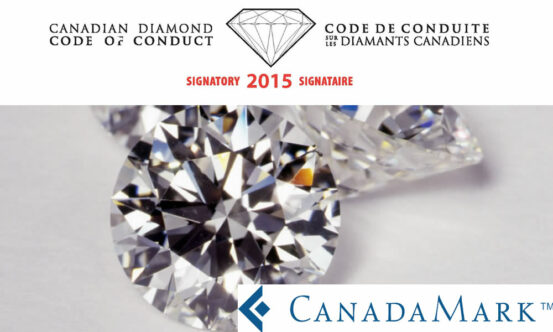Hallmarking, long used in precious metals, is being promoted as a means to differentiate diamond production as plans for industry-wide chain of custody standards are on hold.
Unlike a gold or platinum hallmark, which attests to the composition of the precious metal, a diamond hallmark serves as a certificate of origin to ensure that the diamond has met the sourcing criteria that millennials are demanding.
“We’re dealing with a younger generation which is looking on the internet for social responsibility in the sourcing of their diamonds,” said Marc Altman, of Philadelphia, Pennsylvania-based B&E Jewelers. “They’re the ones who are asking for it, even though it’s a small percentage who do. They like the story of knowing where the diamond comes from.” Altman added that CanadaMark, a hallmarking program which the jeweler recently joined, is particularly appealing for U.S. consumers given that the diamonds are sourced in North America, with no association to conflict diamonds.
For some producers, such as in Canada and Botswana, hallmarking could enable premium pricing for diamonds, with 70 percent of consumers prepared to pay a little more for their purchase, according to James Pounds, Dominion Diamond Corporation’s president and marketing exec. The miner, which relaunched the CanadaMark in May 2014, noted that its goals for the mark extend beyond the conflict diamond issue. It hopes to highlight the environmental stewardship and social responsibility of the Canadian diamond industry, which will ultimately create a premium for the company’s diamond production.
Mais la De Beers et les États-Unis en pâtiraient Chain of custody hurdles
Dominion claims it can create an audit trail from its Ekati and Diavik mines in Canada through the polishing process. The manufacturer receives an invoice and assigns a tracking number to each Dominion diamond designated for CanadaMark, as it is separated from other rough supply during the polishing process. Once polished, the manufacturer enters the information into Dominion’s system, along with the details and characteristics of the stone. A unique serial number is then laser inscribed onto the girdle of the diamond and Dominion issues a CanadaMark certificate.
The difficulty of implementing such segregation on a large scale is frequently cited as a roadblock to implementing the often touted chain-of-custody standards for diamonds.
Calls for claims of provenance
The Responsible Jewellery Council (RJC) has no immediate plans to implement chain of custody for diamonds as it has for gold and platinum, a representative explained in a March 2015 interview. RJC’s code of practices now has a provision that satisfies those entities that wish to make a claim on the provenance of their diamonds, according to the interview. RJC did not respond to Rapaport News’s request for further comment in time for this article.
Martin Rapaport, chairman of Rapaport Group, stressed in a June presentation to U.S. jewelers and diamantaires that hallmarking would help companies differentiate with a chain of custody which recognizes a mine or mining company supplying a product that meets certain ethical standards and physical characteristics.
Not a traditional hallmark…
Such hallmarks, or certificates of origin, differ from other hallmarking in the jewelry industry. Marion Wilson, a director at the Assay Office Birmingham, explained that hallmarking is a U.K. legal requirement which guarantees the precious metal content in a piece of jewelry. This is assessed using scientific processes to determine the amount of either gold, silver, platinum or palladium present. An appropriate hallmark is then applied to every piece, Wilson said.

